验证数据展示
产品信息
84370-1-PBS targets CCL22/MDC as part of a matched antibody pair:
MP01238-2: 84370-3-PBS capture and 84370-1-PBS detection (validated in Cytometric bead array)
Unconjugated rabbit recombinant monoclonal antibody in PBS only (BSA and azide free) storage buffer at a concentration of 1 mg/mL, ready for conjugation. Created using Proteintech’s proprietary in-house recombinant technology. Recombinant production enables unrivalled batch-to-batch consistency, easy scale-up, and future security of supply.
This conjugation ready format makes antibodies ideal for use in many applications including: ELISAs, multiplex assays requiring matched pairs, mass cytometry, and multiplex imaging applications.Antibody use should be optimized by the end user for each application and assay.
| 经测试应用 | Cytometric bead array, Indirect ELISA Application Description |
| 经测试反应性 | human, mouse |
| 免疫原 | Recombinant protein 种属同源性预测 |
| 宿主/亚型 | Rabbit / IgG |
| 抗体类别 | Recombinant |
| 产品类型 | Antibody |
| 全称 | chemokine (C-C motif) ligand 22 |
| 别名 | CCL22, MDC, ccl 22, C-C motif chemokine 22, CC chemokine STCP-1 |
| 计算分子量 | 93 aa, 11 kDa |
| GenBank蛋白编号 | BC027952 |
| 基因名称 | CCL22/MDC |
| Gene ID (NCBI) | 6367 |
| 偶联类型 | Unconjugated |
| 形式 | Liquid |
| 纯化方式 | Protein A purification |
| UNIPROT ID | O00626 |
| 储存缓冲液 | PBS only , pH 7.3 |
| 储存条件 | Store at -80°C. The product is shipped with ice packs. Upon receipt, store it immediately at -80°C |
背景介绍
CCL22, also known as macrophage-derived chemokine (MDC), is a member of the CC chemokine family. It is primarily produced by myeloid cells such as macrophages and dendritic cells (DCs) under steady-state conditions. CCL22 plays a significant role in immune responses by regulating the migration of different subsets of leukocytes. It shares the same receptor, CCR4, which is predominantly expressed by Th2 cells, making CCL22 a key mediator in the development of Th2-dominant diseases such as atopic dermatitis and asthma. Elevated serum levels of CCL22 are observed in patients with these conditions. CCL22 is also expressed in several types of tumor cells and Foxp3+ regulatory T cells (Tregs), suggesting its involvement in attracting Tregs into the tumor microenvironment to evade immune attacks.
